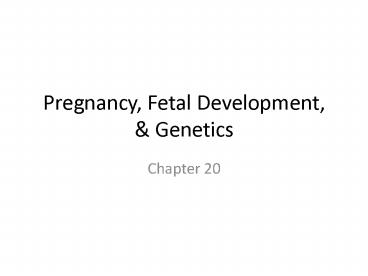Pregnancy, Fetal Development, - PowerPoint PPT Presentation
1 / 44
Title:
Pregnancy, Fetal Development,
Description:
Pregnancy, Fetal Development, & Genetics Chapter 20 Month 8 By the end of the eighth month, the baby weighs about 5 1/2 pounds. Hearing is fully developed. – PowerPoint PPT presentation
Number of Views:303
Avg rating:3.0/5.0
Title: Pregnancy, Fetal Development,
1
Pregnancy, Fetal Development, Genetics
- Chapter 20
2
Objectives
- Describe the process of fertilization
- Describe the major events of cleavage
- Distinguish between an embryo and a fetus
- Describe the major events of the fetal stages of
development
3
Development
- Gradual changes of physical and physiological
characteristics from conception to death
4
LIFE
- Life originates from a single cell the size of a
period at the end of a sentence to trillions of
cells organized into tissue, organs, and organ
systems. - Differentiation is due to genetic instructions
5
Fertilization
- Takes dozens of sperm working together to
penetrate the ova because the ova has a shell
(corona radiate) that is difficult to get through
6
Days 0 - 9
7
Zygote
8
1st Cleavage
9
2 Cell Stage
10
4 Cell Stage
11
Morula
12
Early Blastocyst
13
Blastocyst
- The penetration of the blastocyst into the
uterine wall is referred to as implantation
14
Implantation
15
1st trimester
- 1st 3 months
- After implantation occurs, a cell mass form an
Amniotic cavity around the zygote and fills with
fluids as the zygote develops - During zygote development, a placenta or tube
connects the zygote to the uterine wall. - The rudiments of all major organ systems appear
16
4 weeks
17
4 Weeks
By the end of the first month, the embryo is
about 1/10 of an inch long. The heart, no larger
than a poppy seed, has begun beating.
18
Gastrulation
- 14-16 days after fertilization
- Germ layers are created (p. 546)
- Ectodermal nervous system, portions of special
sensory organs, epidermis, hair, glands of skin
and linings of the mount and anal canal - Mesodermal myo tissue, bone tissue, bone
marrow, blood, blood vessels, connective tissues,
internal reproductive organs, kidneys, epithelial
linings of the body cavities - Endodermal epithelial linings of the digestive
tract, respiratory tract, urinary bladder and
urethra
19
8 weeks
20
Month 2
The embryo grows to 1 inch long and has distinct,
slightly webbed fingers. Veins are clearly
visible. The placenta is already nourishing the
baby through the umbilical cord. The heart has
divided into right and left chambers.
21
12 weeks
22
Month 3
Starting at eight weeks, the baby is called a
fetus. By the end of the first trimester, the
fetus is 2 1/2 to 3 inches long and is fully
formed. He has begun swallowing and kicking. All
organs and muscles have formed and are beginning
to function.
23
2nd trimester
- Development of organs and organ systems
- Fetus looks distinctly human
24
16 weeks
25
Month 4
The baby is covered with a layer of thick, downy
hair called lanugo. The heart beat can be heard
clearly. This is when many mothers feel their
baby's first kick.
26
20 weeks
27
Month 5
A protective coating called vernix caseosa
begins to form on the baby's skin. If you have an
ultrasound, you might see him sucking his thumb.
By the end of this month, the baby will be 8 to
10 inches long and weigh almost a pound.
28
24 weeks
29
Month 6
Tiny eyebrows and eyelids are visible. The baby's
lungs are filled with amniotic fluid, and he has
started to practice breathing movements. The baby
can hear sounds, talking and singing, outside the
uterus.
30
28 weeks
31
Month 7
By the end of the seventh month, the baby weighs
about 2 1/2 pounds and is about 15 inches long.
His body is well formed. Fingernails cover his
fingertips. He may try to turn toward a source of
bright light.
32
3rd trimester
- Final 3 months!!!
- Rapid fetal development
- Most all of the major organs become fully
functional - Usually the largest weight gain
33
32 weeks
34
Month 8
By the end of the eighth month, the baby weighs
about 5 1/2 pounds. Hearing is fully developed.
Studies have shown that babies respond better to
high-pitched voices.
35
36 weeks
36
Month 9
The baby is a around 6 to 9 pounds and measures
somewhere between 19 and 22 inches long. As a
baby becomes more crowded, they move around less.
37
40 weeks
38
Fetal Circulation
- Fetal hemoglobin has a greater O2-carrying
capacity than adult hemoglobin - Umbilical vein carries nutrient rich blood from
placenta to fetus - Ductus venosus conducts ½ the blood from
umbilical vein directly to inferior vena cava,
bypassing the liver - Foramen ovale conveys much blood entering the
R. atrium from inferior vena cava, thru the
atrial septum and into the L. atrium, bypassing
the lungs - Ductus arteriosus conducts some blood from the
pulmonary trunk to the aorta, bypassing the lungs
39
(No Transcript)
40
Milk Secretion
- Human milk content
- 4.5 fat
- 1.1 protein
- Cows milk content
- 3.5 fat
- 3.1 protein
41
Genetics
- Chromosome (23 pairs)
- Autosomes pairs 1-22
- Sex determination 1 pair
- XX female
- XY male
- X chromosomes carry 750 genes
- Y chromosomes carry 78 genes
- Genes the working subunits of DNA
42
Genes
- Alleles variant forms of a gene
- Homozygous an individual who has 2 indentical
alleles of a gene - Heterozygous a person with 2 different alleles
carrier - Dominant vs. Recessive
- Dominant alleles can mask recessive alleles
43
Hereditary
- Punnett Squares uses logic to deduce the
probabilities of inheriting particular genotypes
in offspring
44
Lifes Greatest Miracle
- Please remember to answer your questions during
the film, these are participation points! - The movie































